Fatal Dog Attack Statistics
DogsBite.org recorded 48 fatal dog attacks in 2019, the highest recorded in a single year. Pit bulls contributed to 69% (33) of these deaths, followed by "mixed-breed," involved in 6 deaths. For the first time, the 30-49 age group sustained more deaths (13) than the 0-4 age group (12). Pit bulls inflicted 85% of these adult deaths. The last time the CDC collected breed data about dogs involved in fatal human attacks was 1998. Pit bulls have killed over 415 Americans since.
- 48 U.S. dog bite-related fatalities occurred in 2019. Despite being regulated in Military Housing areas and over 900 U.S. cities, pit bulls contributed to 69% (33) of these deaths. Pit bulls make up about 8% of the total U.S. dog population.
- During the 15-year period of 2005 to 2019, canines killed 521 Americans. Two dog breeds, pit bulls (346) and rottweilers (51), contributed to 76% (397) of these deaths. 35 different dog breeds were involved in the remaining fatal dog maulings.
- In 2019, the combination of pit bulls (33), American bulldogs (1), rottweilers (4) and mastiff-type guard dogs and war dogs (1) -- the types used to create "baiting" bull breeds and fighting breeds -- accounted for 81% (39) of all dog bite-related deaths.
- See full report: 2019 U.S. Dog Bite Fatality Statistics - DogsBite.org
- News release: Nonprofit Releases 2019 Dog Bite Fatality Statistics - Attacks and Adult Victims Rise and Trends from the 15-Year Data Set
Data Collection Method: How We Collect U.S. Dog Bite Fatality Data
Discussion Notes
DogsBite.org - From April to December 2019, our nonprofit sent out public records requests to 13 different law enforcement or coroner departments to uncover fatal dog maulings not reported in the media or to obtain more information about an existing case. We uncovered 2 new fatal pit bull maulings from earlier years (2008 and 2017). Both attacks occurred in Detroit. We also discovered that 1 dog bite fatality in 2019 was falsely attributed to a "cattle dog" instead of a pit bull-mix.
In 2019, there was a substantial rise in fatal dog maulings -- 48 deaths. There was also a larger diversity of dog breeds than we normally see. 14 different dog breeds were involved in the 48 deaths, and 8 of these dog breeds were attributed to 1 death each. 2019 also saw the highest year on record of adults killed by dogs. 73% (35) of all victims were ≥ 10 years old. This is likely due to the never-before seen high number of deaths in the 10-29 and 30-49 age groups in 2019.
In 2019, there were 5 victims in the combined 10-29 age group, a rare age group among dog bite fatality victims. Pit bulls were responsible for 80% (4) of these deaths. A pack of protection-bred dogs inflicted the other death. In 2019, pit bulls killed in every single age group: 0-2 years, 3-4 years, 5-9 years, 10-18 years, 19-29 years, 30-49 years, 50-69 years and 70+ years. Whereas, all other dog breeds combined primarily killed children ≤ 2 years old and adults ≥ 50 years old.
This year, when examining the single year of 2019 and the combined 15 years of fatal dog attack statistics, we review multiple tables and charts. In 2017, we first began examining how traditional dog bite fatality metrics have changed or remained the same since the early CDC studies. This review is a continuation of that process, as we measure these trends over a 15-year period.
Adult Deaths, 30-49, Rise Metric Shift
During 2019, the 30-49 age group suffered the most deaths (13). While deaths in this age group have been rising since 2005, odds are low this age group of able-bodied adults had more deaths than 0-4 years old. Pit bulls inflicted 85% (11) of these adult deaths. 31% (4) were owner-directed attacks, and all four victims were female. In 3 cases, the dogs had attacked the female owner prior to killing her. In 1 case, the dogs had attacked a neighbor eight days before killing the owner.
62% (8 of 13) of the dogs that killed in the 30-49 age group had a previous bite history. 62% of attacks involved multiple dogs, and 62% occurred off the owner's property, a rate over 2.5 times higher than the 14-year average (2005 to 2018). 62% of victims were female; two male victims were killed by "packs" of dogs; and two victims were homeless ages 36-38 years. Given these set of factors, for the first time, victims 30-49 years old sustained more deaths than 0-4 years old.
In fact, this single adult age group sustained as many deaths as children 0-9 years old in 2019, each comprising 27% of all dog bite fatalities.
Studies from previous years shows the 30-49 age group is the fastest rising group. There has been a 433% increase since the 1979-1988 study (3% to 16%). Children 0-9 years is the only decreasing group. Children 0-9 years used to comprise 70% of all fatality victims. The most recent 5-year period of 2015-2019 shows that children 0-9 years has fallen to 36% of victims, a 49% decrease. While percentages of victims ≥ 50 years have doubled since the 80s (21% to 41%).
| 0-9 | ≥ 10 | 10-29 | 30-49 | 50-69 | 70+ | Total | Years | Entity/Study |
|---|---|---|---|---|---|---|---|---|
| 70% | 30% | 6% | 3% | 11% | 10% | 157 | 1979-1988 | CDC/Sacks 1989 |
| 57% | 43% | 5% | 9% | 10% | 19% | 108 | 1989-1994 | CDC/Sacks, 1996 |
| 51% | 49% | 7% | 11% | 14% | 17% | 150 | 2005-2009 | DogsBite.org, 2020 |
| 50% | 50% | 3% | 13% | 17% | 17% | 179 | 2010-2014 | DogsBite.org, 2020 |
| 36% | 64% | 7% | 16% | 23% | 18% | 192 | 2015-2019 | DogsBite.org, 2020 |
| 27% | 73% | 10% | 27% | 19% | 17% | 48 | 2019 | DogsBite.org, 2020 |
Off Property Attacks
In 2019, off-property attacks rose to 42% (20), a 75% rise from the 14-year average of 24%. Pit bulls were involved in 75% (15) of off-property attacks and 95% (19) involved multiple dogs. Only 35% (7) of these cases resulted in criminal charges. In 13 cases, dog owners faced no criminal culpability after their multiple dogs (ranging from 2 to 8 dogs) escaped the owner's property and brutally killed a person. 70% (14) of off-property attacks occurred in the Southern United States.1
At least four more off-property attacks should have resulted in charges, but did not, including the death of Jaysiah Chavez, 2, who was in his own yard when two roaming rottweilers attacked him. Two deaths involved dogs with a reported history of aggression escaping their property and killing a person. Both victims -- Cledith Davenport and Medessa Ragsdale -- were discovered "dead in a ditch." Also, Dianne Reves was killed by a pack of 7 large dogs while in her own backyard.
In all four cases, the negligence was clear. Two of these deaths occurred in California and Texas too, states with a felony dog attack statue. The rottweilers in California had a history of digging out from under the fence. The pit bulls in Texas had a history of violence and had attacked another adult just before or after killing Ragsdale. The death of Reves in Mississippi should have resulted in manslaughter charges because a roaming pack of 7 large dogs is dangerous by default.
Prosecutors should not have to prove the owner had previous knowledge of the dogs' vicious propensities in cases involving dog pack attacks.
Poor Shelter Policies
2019 marks the first year when a volunteer or staff member was fatally mauled at a shelter facility by a dog currently up for adoption. 2019 also marks the first year when a person was killed by a dog at a veterinary facility. Thus, there were two dog bite fatalities that occurred within a county shelter or veterinary facility in 2019, indicating that safety standards at both are at historically low levels or that the housing of violent dogs has increased, in addition to poor safety standards.
In 2019, two fatalities occurred due to lack of bite quarantine space or a "limited" admission policy. After the Irving Animal Shelter refused to house two biting pit bulls due to quarantine space being "at capacity," the dogs killed their owner while in quarantine at a private veterinary facility. After a pit bull owner tried to surrender his dogs to Lubbock Animal Services for attacking a man and killing a dog, he was told he had to wait four days. Two days later, the dogs killed his neighbor.
One death involved both factors -- the owner was refused by the shelter, only to be killed at the veterinary clinic -- thus totaling only three deaths.
Poor shelter policies contributed to a fourth death in 2019 as well. In late June, a pit bull-mix killed its 54-year old female owner in Ventura County. In March, the same dog had violently attacked its owner, fully severing her right ear and mauling her face and arm. Despite the severity of the March attack, which was the second bite to the victim's face since that January, Ventura County Animal Services gave the dangerous dog back to the family. Three months later, the dog killed its owner.
Speaking of poor safety policies and leadership from shelters, 2019 also marks the year when a pit bull with a checkered past owned by Annie Hornish, a senior state director of the Humane Society of the United States, killed a woman visiting her home. Hornish then denied this act. At a recent dangerous dog hearing, we learned that Dexter was also unneutered. That surgery should have been done immediately upon Hornish adopting the dog, 4.5 months before the fatal attack.
Multi-Dog Attacks Rise Metric Shift
In 2019, 63% (30) of fatal dog attacks involved multiple dogs, a sharp rise from the 14-year average of 45%, and the highest percentage on record since 2005. 70% (21) of multi-dog attacks involved 2 or 3 dogs and 30% (9) involved 4 or more dogs. 63% (19) involved 1 or more pit bulls as well. In 8 deaths, only 1 dog was implicated, but the household had additional dogs. Thus, 79% (38) of cases involved households with multiple dogs, such as the death of Nicholas Farris.
Fatal dog attacks involving a single dog have been falling since the 1980s. During the early CDC study (1979-1988), 70% of fatal attacks only involved 1 dog. This has fallen to 49% in the last 5-year period of 2015-2019, a 30% decrease. Comparing the same two periods, attacks involving ≥ 3 dogs have risen from 11% to 29%, a 164% increase. In 2019, fatal attacks involving ≥ 3 dogs comprised 38% of dog bite fatalities and pit bulls were involved in 78% of these deaths (14 of 18).
Multi-dog attacks involving only 2 dogs are similar across all periods studied (19-23%). Only attacks involving ≥ 3 dogs is significantly rising.
| % Single Dog | Of Total | % ≥ 3 Dogs | Of Total | Years | Entity/Study | |
|---|---|---|---|---|---|---|
| 70% | (76 of 108) | 11% | (12 of 108) | 1979-1988 | CDC/Sacks 1989 | |
| 73% | (62 of 85) | 6% | (5 of 85) | 1989-1994 | CDC/Sacks, 1996 | |
| 67% | (160 of 238) | 12% | (29 of 238) | 1979-1998 | CDC/AVMA, 2000 | |
| 53% | (80 of 150) | 19% | (28 of 150) | 2005-2009 | DogsBite.org, 2020 | |
| 57% | (102 of 179) | 22% | (39 of 179) | 2010-2014 | DogsBite.org, 2020 | |
| 49% | (95 of 192) | 29% | (55 of 192) | 2015-2019 | DogsBite.org, 2020 | |
| 38% | (18 of 48) | 38% | (18 of 48) | 2019 | DogsBite.org, 2020 | |
Pit Bulls and Multi-Dog attacks Metric Shift
When analyzing a chart of year-by-year over the 15-year period, one can see that multi-dog attacks involving 1 or more pit bulls is the primary driver in the rise of multi-dog attacks resulting in death, especially since 2012. This trend continues to have an upward trajectory too. Whereas, multi-dog attacks involving all other dog breeds combined has a flat linear trend line. Over the 15-year period, pit bulls have been involved in 73% of all fatal multi-dog attacks (177 of 244).
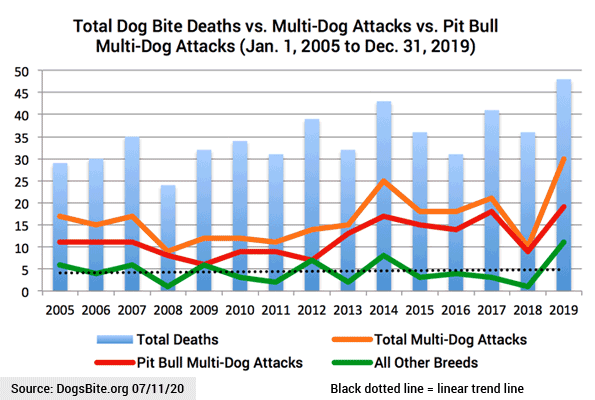
Dog ownership has changed since the CDC examined fatal dog attacks 20 years ago. Today, more owners have 2 or more dogs, and increasingly in fatal attacks, the household has 1 or more pit bulls included in the multi-dog mix. In the Farris case, his mother had just rescued another dog, "making it 4 dogs" in the home, 2 of which were pit bull-mixes. Few dog owners can successfully teach the "stay" command to 1 dog, much less responsibly manage multiple large bull breeds.
Having a "dog pack" with pit bulls in your home has become trendy too. When you have 1 dog, you manage your relationship with the dog and other household members. When you have 2 dogs, you also manage the relationship between the dogs. When you have 3 or more dogs and 1 or more are pit bulls, you must manage the relationships between all of the dogs and the "dog pack" mentality relationship. Again, all while none of the dogs can perform the "stay" command.
The family "dog pack" with pit bulls trend will continue to increase multi-dog attacks inflicted on family members and non-family members alike.
In the case of Tanner Kinnamon, he was killed by his aunt's 2 rescue pit bulls. At the time, 4 other pit bull-type dogs belonging to his aunt were crated in her home. His aunt owned a "dog pack" of pit bulls and only 2 of these dogs could be out of their crates at the same time. The 4 other dogs were kept crated in separate rooms. This is how the aunt "managed" her "dog pack" of pit bulls. The 2 pit bulls that did get along outside of their crates are the very dogs that killed the boy too.
Examining Death Rates Metric Shift
The last chart we examine discusses death rates across four periods. The first period, 1989-1994, is the most recent CDC study period where comparison data was available.2 The next three periods is 15 years of our nonprofit's data divided into 5-year periods. The "death rate" is deaths per 100 million population per year. Between the first and last periods (2015-2019), the death rate of dog bite fatalities has risen from 7.1 to 11.82. This is a 66% increase since the early 90s.
The pit bull death rate (or kill rate) has risen from 1.57 to 8.62. This is a 449% increase since the early 90s. In the last 5 years, more fatal dog attacks have occurred than ever before, and pit bulls are a primary factor driving the rising total death rate. We also measured fatal attacks involving 3 or more dogs, which were infrequent during this CDC study period. Deaths by 3 or more dogs have risen by 935% since the early 90s and by 82% since our first data set (2005-2009).
While writing this post, the question was put to us: "Is there a way to show that multi-dog attacks are additional attacks? Not just that the dynamics of dog ownership are changing over time?" Yes. The Death Rates chart shows that the pit bull and multi-dog attack death rates are growing at a faster pace than the total dog bite fatality death rate. The pit bull death rate is growing 2.5 times faster and the ≥ 3 dogs involved death rate is growing 4 times faster since the 2005-2009 period.
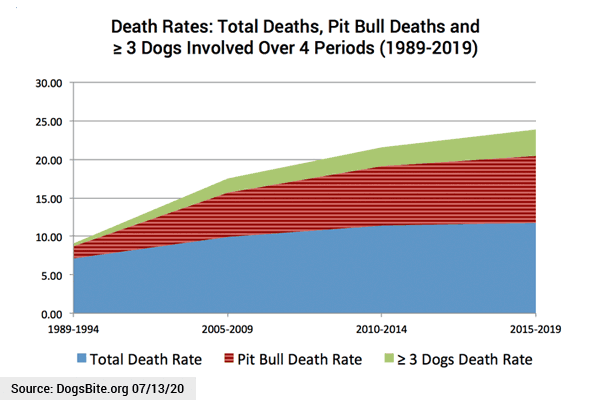
Download the PDF file to see all of the values: Death Rates Over 4 Periods (1989 to 2019).
Summary and Call-to-Action
In 2019, several new records were set, including: the most fatal dog attacks recorded in a single year, 48; the highest percentage of fatal multi-dog attacks, 63%; and the highest percentage of adults, ages 30-49, killed by dogs, 27%. There is no single reason why so many adults, chiefly females, in the 30-49 age group were killed by dogs, however, pit bulls were involved in 85% of these attacks, 62% of the dogs had a previous bite history, and 62% involved multiple dogs.
Looking at 15-years of data in 5-year sets shows that the pit bull death rate and the ≥ 3 dog death rate are rising much faster than the total death rate. Data from 1989-1994 shows this has been true for some years as well. Among pit bull victims, we released data last October showing that women ≥ 30 years old is the fastest rising gender and age group of pit bull victims. The year of 2019 only furthers this trend. Pit bulls were responsible for 65% of female deaths ≥ 30 years old.
Your Action Can Help
This year our Call-to-Action involves a U.S. Senate bill soon to be considered by the U.S. House of Representatives. The Pit Bull Lobby already sent out a robo-email to thousands of their members. Senate Bill 4049, which authorizes military spending, also forces the removal of all military pit bull regulations. Please write to your Representative and request that Section 1050 -- Department of Defense policy for the regulation of dangerous dogs -- be stricken from the bill.
Privatized housing for military has a high density of children. From 2009 to 2012, the U.S. Marine Corps, U.S. Army and U.S. Air Force enacted uniform pet polices prohibiting several breeds from base and privatized housing, primarily: pit bulls, rottweilers and wolf-dog hybrids. They did so because these breeds pose an "unreasonable risk to the health and safety" of personnel in family housing areas. Severe and fatal dog maulings had been occurring in military housing as well.
Additional Annual and Combined Year Statistical Graphics (2005 to 2019)
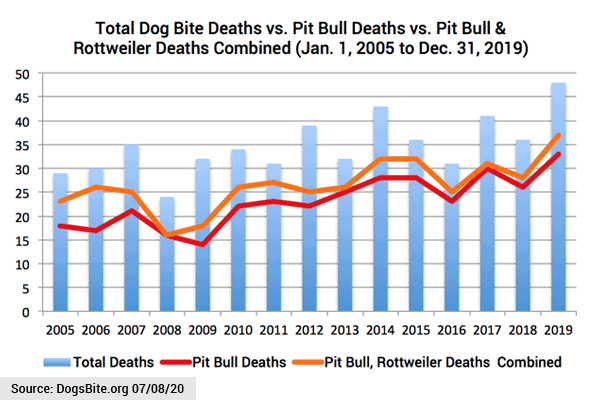
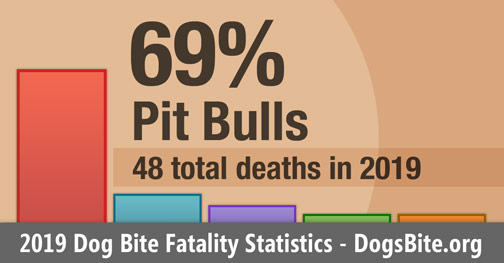
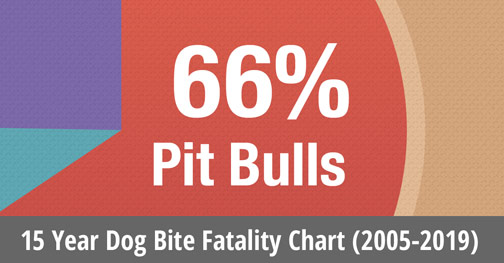
Data Collection Method: How We Collect U.S. Dog Bite Fatality Data
2The most recent set of 5-6 consecutive years of data for comparison: Fatal Dog Attacks, 1989-1994, by Sacks JJ et al., Pediatrics, 1996. Of the 109 total deaths studied, information about the number of dogs involved was only known for 85 deaths, 78%. What is known is that 94% of the 85 deaths involved only 1 or 2 dogs.
Related items:
15-Year U.S. Dog Bite Fatality Chart by Breed (2005 to 2019)
15-Year U.S. Dog Bite Fatality Chart by Age Groups (2005-2019)
Summary of Factors and Scenarios Over 15-Year Period (2005-2019)
Dog Bite Deaths and Death Rates Over 4 Periods (1989 to 2019)
2019 Fatal Dog Attack Breed Identification Photographs
Recent multi-year reports:

Thank you, Colleen, for taking much time and effort to compile this exhaustive, comprehensive and invaluable report. The time to remove this tragic scourge from our midst is now!
Great job putting this all together in a cohesive package, Colleen.
This will be very useful in telling people, when they are looking for a dog–why they should avoid pitbulls especially those who are not dog-experienced.
Thank you for this great public service.
Another problem I noted is that *packs* of dogs are more likely to attack than a single dog. Or it’s more likely one or more dogs will attack the owner, breaking up a fight between numerous dogs.
When I was dog training, I often had numerous dogs in my house at one time.
HOWEVER, my personal main dog was highly trained, my secondary dog was well-trained. No dogs were running loose unless they had already received some major training and no untrained dogs were ever loose in the pack. I never had a major dogfight in my house. In years.
The point of a “super stable and trained dog” is that yes, it *will* help train the other dogs in social behaviour and model good behaviour and assist in other dogs understanding which words go with which actions as dogs can learn by observation.
There’s an ongoing trend right now of getting one dog. It’s unstable and ill-behaved so the owners obtain a *second* untrained dog to “help” the first one and too often, before that group is stabilized, more dogs are added to the mix. This creates a highly volatile situation.
Interesting to see that statistics bear out what I learned by observation of multiple dog owners.
You are sooo right about this trend. Most of the time I hear the excuses that the first dog (pit) was having “anxiety” while the owner is at work or the dog is “high energy and should have a playmate.” They get a second pit to alleviate these situations and only compound the dangers. They can’t walk both of the dogs together because they are too strong and untrained. This results in alternating them on walks so the walks become shorter and the dog uses up less of its energy. This also results in “just opening the backdoor” and letting them run around a small back yard full of dogshit. Again, they don’t get much exercise and now, little to no socialization. So many problems with this trend….
I absolutely agree with the “rescue dogs are just a way to excuse training failures” school of thought.
The second dog I mentioned? Got her with two sprung ribs, covered in cigarette burns. Now THAT’s abuse. Screamed every time it saw a human. Took a year to fix that GSD but she wound up being utterly lovely, stable and sound.
If that’s fixable with enough commitment and work I have little patience for spoiled, barking, biting monstrosities and excuses.
I also blame the rescues. When I was looking for a dog, when I told them I could fix a dog with balanced training they quite literally, in some cases, hung up on me or palmed me off.
They didn’t want to adopt out dogs. They wanted a neurotic cookie pusher (nothing wrong with treat training but it isn’t the be-all, end-all without combinations of tactics) that would endlessly financially support their “rescue mission”.
It’s a rescue *business* and has no more to do with the welfare of dogs in society than the military industrial complex is interested in peace.
I wonder if the rise in fatal attacks on adults has anything to do a possible increase in unreported fatal maulings. A case of a child killed inside the home likely receives more police attention than the case of a homeless man found dead in an alley, or a woman found dead in her home with her clearly guilty pit bull, and thus more media attention.
I just watched a news video that had nothing to do with dogs or pets, but in which people were being interviewed within their homes.
One family had two babies, a preschooler, two toy-breed dogs, and two pit bulls all in their home at once. Seeing one of the babies crawl on the floor as the dogs milled around him was chilling. Ironically, the mother was talking about access to medical care and her concerns about her family’s health.
I can’t belive that Dexter is still alive and that that nut Annie Hornish is still pushing her theories in which she blames a professional health care worker. I would not mind her getting that dog back as long as she becomes his next victim.
Thank you for alerting us about the Senate Bill. I’ll be writing to my represntative asap.
I’m not surprised that multi-dog attacks are on the rise. Way too many pit people own more than one of these beasts. I’ve seen many with up to 4! There is no reason to even one one of these things, let alone 4 of them. I don’t see understand how it is legal to have multiple killer animals in your home.
Thanks for putting all the work and diligence into this compilation of statistics.
I have a neighbor with a pack of 8 dogs, all “rescues,” all gotten impulsively (to “save them”), all acquired within a period of just several months, kept in a very small yard with a doggy door to come and go into their house. I hear dog fights all the time. The owner has put no real training into the dogs, and they rule the home. Although none are pits (one does look like a mix), I see a capacity in this untrained, unexercised, restless pack to create havoc if they ever “somehow got out.” I have no doubt they would attack another animal and possibly a person in the right circumstances.
I’ve seen a gentle, well-trained American Eskimo dog join in with the killing of a goat due to the pack mentality. This was a dog which had been raised around all kinds of stock, but when the other dog attacked the goat she did too. I was just a child but I found myself uttering the same things pit owners do… “She’s never done this before! She’s a good dog and would never hurt a fly!” No, she was a dog. And the lure to join in with another dog is very strong, stronger than her training, stronger than her gentleness. Her beautiful white fur stained with the blood of that goat has stuck in my mind as proof of what the pack mentality can do.
With normal dogs, it’s dangerous. With pits and other fighting breeds, it’s deadly.
The sad part is Anon, that these deluded people see themselves as “saving” these dogs.
Dogs want one thing. They want to hang out with their owners. They want to know what behaviour is expected of them so they will be rewarded by humans instead of ignored or vilified.
Eight dogs in a tiny, poop infested yard, leading a miserable existence because it makes the owners feel altruistic–while they commit heinous selfishness at the expense of those dogs and all the people that come in contact with them.
No stability in the pack. Not enough attention from the owners. Not enough training, grooming, mental/physical stimulation. That’s abuse in my book.
A disaster in the making for all, involved.
You’ve hit the nail on the head here. Those dogs have been “saved” from an overcrowded shelter where none can receive the attention it needs, just to be put into an overcrowded home where none can receive the attention it needs. All so a person can feel good about themselves for a little while. I didn’t add that this couple is “rescuing” dogs while barely able to care for themselves and a child due to health and mental/emotional issues. If these were pits, it would be a ticking time bomb. Thankfully none seem able to escape the fencing. So as it is (as long as they’re contained), it’s just a sad existence for the dogs and the child while the adults can smile and pat themselves on the back for being rescue heroes.
I was surprised and horrified that so many celebrities are pit bull advocates and post pictures of their dogs on intragram.
Are there any stats on male/female pit bulls? Are the females less likely to attack?